Pataliputra
Pataliputra (IAST: Pāṭaliputra), adjacent to modern-day Patna, was a city in ancient India, originally built by Magadha ruler Udayin in 490 BCE as a small fort (Pāṭaligrāma) near the Ganges river.[1]
| Pilgrimage to |
| Buddha's Holy Sites |
|---|
 |
| The Four Main Sites |
| Four Additional Sites |
| Other Sites |
|
| Later Sites |
|
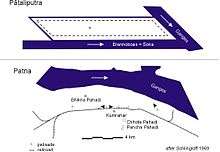 Plan of Pataliputra compared to present-day Patna | |
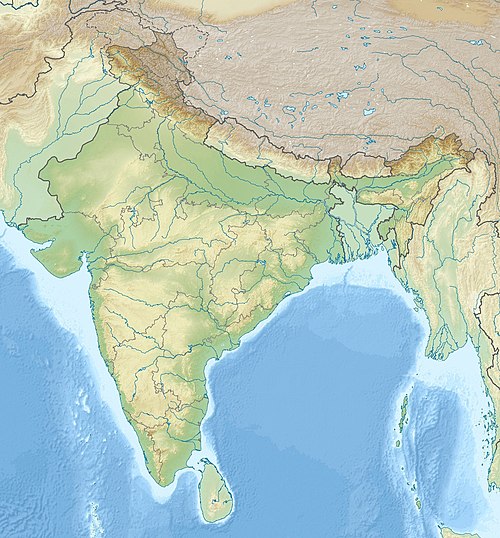 Shown within India  Pataliputra (Bihar) | |
| Alternative name | Pātaliputtā (Pāli) |
|---|---|
| Location | Patna district, Bihar, India |
| Region | South Asia |
| Coordinates | 25°36′45″N 85°7′42″E |
| Altitude | 53 m (174 ft) |
| Length | 14.5 km (9.0 mi) |
| Width | 2.4 km (1.5 mi) |
| History | |
| Builder | Ajatashatru |
| Founded | 490 BCE |
| Abandoned | Became modern Patna |
| Associated with | Haryankas, Nandas, Mauryans, Shungas, Guptas, Palas, Sher Shah Suri |
| Management | Archaeological Survey of India |
It became the capital of major powers in ancient India, such as the Shishunaga Empire (c. 413–345 BCE), Nanda Empire (c. 460 or 420–325 BCE), the Maurya Empire (c. 320–180 BCE), the Gupta Empire (c. 320–550 CE), and the Pala Empire (c. 750–1200 CE). During the Maurya period (see below), it became one of the largest cities in the world. As per the Greek diplomat, traveler and historian Megasthenes, during the Mauryan Empire (c. 320–180 BCE) it was among the first cities in the world to have a highly efficient form of local self government.[2] Afterwards, Sher Shah Suri (1538–1545) revived Pataliputra, which had been in decline since the 7th century CE, and renamed it Paṭna.
Extensive archaeological excavations have been made in the vicinity of modern Patna.[3][4] Excavations early in the 20th century around Patna revealed clear evidence of large fortification walls, including reinforcing wooden trusses.[5][6]
Etymology
The etymology of Pataliputra is unclear. "Putra" means son, and "pāṭali" is a species of rice or the plant Bignonia suaveolens.[7] One traditional etymology[8] holds that the city was named after the plant.[9] Another tradition says that Pāṭaliputra means the son of Pāṭali, who was the daughter of Raja Sudarshan.[10] As it was known as Pāṭali-grāma ("Pāṭali village") originally, some scholars believe that Pāṭaliputra is a transformation of Pāṭalipura, "Pāṭali town".[11] Pataliputra was also called Kusumapura (city of flowers).
History
There is no mention of Pataliputra in written sources prior to the early Jain and Buddhist texts (the Pali Canon and Āgamas), where it appears as the village of Pataligrama and is omitted from a list of major cities in the region.[12] Early Buddhist sources report a city being built in the vicinity of the village towards the end of the Buddha's life; this generally agrees with archaeological evidence showing urban development occurring in the area no earlier than the 3rd or 4th Century BCE.[12] In 303 BCE, Greek historian and ambassador Megasthenes mentioned Pataliputra as a city in his work Indika.[13]Diodorus, quoting Iambulus mention that the king of Pataliputra had a " great love for the Greeks ".[14]
The city of Pataliputra was formed by fortification of a village by Haryanka ruler Ajatashatru, son of Bimbisara.[15]
Its central location in north eastern India led rulers of successive dynasties to base their administrative capital here, from the Nandas, Mauryans, Shungas and the Guptas down to the Palas.[16] Situated at the confluence of the Ganges, Gandhaka and Son rivers, Pataliputra formed a "water fort, or jaldurga".[17] Its position helped it dominate the riverine trade of the Indo-Gangetic plains during Magadha's early imperial period. It was a great centre of trade and commerce and attracted merchants and intellectuals, such as the famed Chanakya, from all over India.
Two important early Buddhist councils are recorded in early Buddhist texts as being held here, the First Buddhist council immediately following the death of the Buddha and the Second Buddhist council in the reign of Ashoka. Jain and Brahmanical sources identify Udayabhadra, son of Ajatashatru, as the king who first established Pataliputra as the capital of Magadha.[12]
Capital of the Maurya Empire
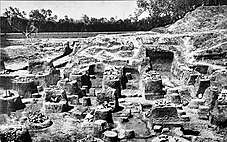
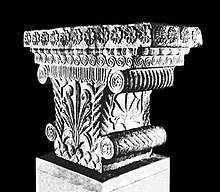

During the reign of Emperor Ashoka in the 3rd century BCE, it was one of the world's largest cities, with a population of about 150,000–400,000.[18] The city is estimated to have had a surface of 25.5 square kilometers, and a circumference of 33.8 kilometers, and was in the shape of a parallelogram and had 64 gates (that is, approximately one gate every 500 meters).[19] Pataliputra reached the pinnacle of prosperity when it was the capital of the great Mauryan Emperors, Chandragupta Maurya and Ashoka. The city prospered under the Mauryas and a Greek ambassador, Megasthenes, resided there and left a detailed account of its splendour, referring to it as "Palibothra":
"Megasthenes says that on one side where it is longest this city extends ten miles in length, and that its breadth is one and threequarters miles; that the city has been surrounded with a ditch in breadth 600 feet, and in depth 45 feet; and that its wall has 570 towers and 64 gates." Arrian, "The Indica"[20]
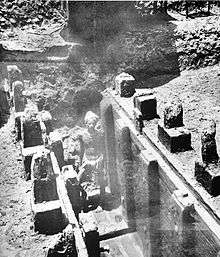
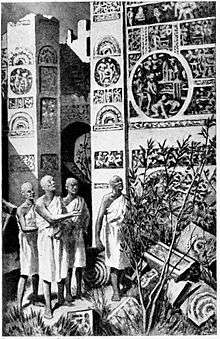
Strabo in his Geographia adds that the city walls were made of wood. These are thought to be the wooden palisades identified during the excavation of Patna.[21]
"At the confluence of the Ganges and of another river is situated Palibothra, in length 80, and in breadth 15 stadia. It is in the shape of a parallelogram, surrounded by a wooden wall pierced with openings through which arrows may be discharged. In front is a ditch, which serves the purpose of defence and of a sewer for the city." Strabo, "Geographia"[22]
Aelian, although not expressly quoting Megasthenes nor mentioning Pataliputra, described Indian palaces as superior in splendor to Persia's Susa or Ectabana:
"In the royal residences in India where the greatest of the kings of that country live, there are so many objects for admiration that neither Memnon's city of Susa with all its extravagance, nor the magnificence of Ectabana is to be compared with them. (...) In the parks, tame peacocks and pheasants are kept." Aelian, "Characteristics of animals"[23]
Under Ashoka, most of wooden structure of Pataliputra palace may have been gradually replaced by stone.[24] Ashoka was known to be a great builder, who may have even imported craftsmen from abroad to build royal monuments.[25] Pataliputra palace shows decorative influences of the Achaemenid palaces and Persepolis and may have used the help of foreign craftmen.[26] Which may be the result of the formative influence of craftsmen employed from Persia following the disintegration of the Achaemenid Empire after the conquests of Alexander the Great.[27][28]
Capital of later dynasties
The city also became a flourishing Buddhist centre boasting a number of important monasteries. It remained the capital of the Gupta dynasty (3rd–6th centuries) and the Pala Dynasty (8th-12th centuries). When Faxian visited the city in 400 A.D, he found the people to be rich and prosperous; they practised virtue and justice.[29] He found that the nobles and householders of the city had constructed several hospitals in which the poor of all countries, the destitute, the crippled and the diseased can get treatment. They could receive every kind of help gratuitously. Physicians would inspect the diseases, and order them food, drink, and medicines.[30] The city was largely in ruins when visited by Xuanzang, and suffered further damage at the hands of Muslim raiders in the 12th century.[31] In a fanciful 1559 book about world geography, the Italian Caius Julius Solinus briefly mentions a powerful Indian kingdom of Prasia with a capital at Palibotra.[32] Afterwards, Sher Shah Suri made Pataliputra his capital and changed the name to modern Patna.
Structure
Though parts of the ancient city have been excavated, much of it still lies buried beneath modern Patna. Various locations have been excavated, including Kumhrar, Bulandi Bagh and Agam Kuan.
During the Mauryan period, the city was described as being shaped as parallelogram, approximately 1.5 miles wide and 9 miles long. Its wooden walls were pierced by 64 gates. Archaeological research has found remaining portions of the wooden palisade over several kilometers, but stone fortifications have not been found.[33]
Excavated sites of Pataliputra
As dynastic capital
- Pataliputra served as the capital under various Indian dynasties
.png) Pataliputra served as the capital of the Haryanka dynasty and the Shishunaga dynasty of Magadha.
Pataliputra served as the capital of the Haryanka dynasty and the Shishunaga dynasty of Magadha. Pataliputra served as the capital of the Nanda Empire.
Pataliputra served as the capital of the Nanda Empire. Pataliputra served as the capital of the Maurya Empire.
Pataliputra served as the capital of the Maurya Empire.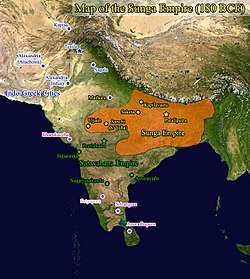 Pataliputra served as the capital of the Shunga Empire.
Pataliputra served as the capital of the Shunga Empire. Pataliputra served as the capital of the Pala Empire.
Pataliputra served as the capital of the Pala Empire. Pataliputra served as the capital of the Gupta Empire.
Pataliputra served as the capital of the Gupta Empire.
Main recovered artifacts
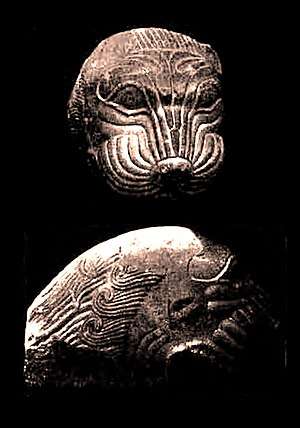 The Masarh lion, 3rd century BCE.
The Masarh lion, 3rd century BCE.
- Portion of pillar, found in Pataliputra.
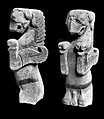 Pataliputra griffin statuette.
Pataliputra griffin statuette.- Winged griffin.
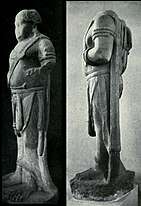 Pataliputra Yakshas, with Mauryan inscriptions.
Pataliputra Yakshas, with Mauryan inscriptions. Kumrahar coping stone with vines.
Kumrahar coping stone with vines. Pataliputra lotus motifs.
Pataliputra lotus motifs.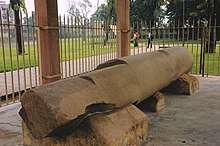 Polished pillar from Pataliputra.
Polished pillar from Pataliputra. Mason marks at the base of a pillar.[34]
Mason marks at the base of a pillar.[34]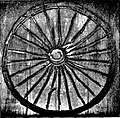 Charriot wheel, Bulandi Bagh, Mauryan period.
Charriot wheel, Bulandi Bagh, Mauryan period. Bulandi Bagh female statuette, Sunga period.
Bulandi Bagh female statuette, Sunga period. Buddhist railing, Sunga period.
Buddhist railing, Sunga period.
See also
References
| Wikimedia Commons has media related to Pataliputra. |
- Kulke, Hermann; Rothermund, Dietmar (2004), A History of India, 4th edition. Routledge, Pp. xii, 448, ISBN 978-0-415-32920-0.
- Schwanbeck, E.A. (4 October 2008). Ancient India as described by Megasthenes and Arrian (First published 1657) (23 ed.). Bibliolife.
- "Patna". Encyclopædia Britannica. Encyclopædia Britannica Online. Encyclopædia Britannica Inc., 2013. Web. 13 Dec. 2013 <"Patna | India". Archived from the original on 30 November 2011. Retrieved 30 January 2011.>.
- "Heritage wall for Metro corridor plan". Archived from the original on 22 November 2016.
- "A relic of Mauryan era". Archived from the original on 27 November 2017.
- Valerie Hansen Voyages in World History, Volume 1 to 1600, 2e, Volume 1 pp. 69 Cengage Learning, 2012
- Monier-Williams Sanskrit-English Dictionary: Pāṭali, "Archived copy". Archived from the original on 16 July 2011. Retrieved 20 July 2009.CS1 maint: archived copy as title (link) (a junior synonym of Stereospermum colais "View crop". Archived from the original on 22 July 2011. Retrieved 20 July 2009.)
- Encyclopaedia of Religion and Ethics, p.677
- Folklore, Vol. 19, No. 3 (30 September 1908), pp. 349–350 Archived 10 May 2018 at the Wayback Machine
- The Calcutta Review Vol LXXVI (1883), p.218
- Language, Vol. 4, No. 2 (June , 1928), pp. 101–105 Archived 10 May 2018 at the Wayback Machine
- Sujato, Bhikkhu; Bhikkhu, Brahmali, "1.1.5", The Authenticity of the Early Buddhist Texts (PDF), Oxford Center for Buddhist Studies, archived from the original on 20 November 2017CS1 maint: BOT: original-url status unknown (link).
- Tripathi, Piyush Kumar (16 July 2015). "Realty to broaden horizon". The Telegraph. Calcutta. Archived from the original on 16 July 2015.
- DIODORUS SICULUS -LIBRARY OF HISTORY-Book II, 60
- Sastri 1988, p. 11.
- Thapar, Romilak (1990), A History of India, Volume 1, New Delhi and London: Penguin Books. Pp. 384, ISBN 978-0-14-013835-1.
- The Pearson Indian History Manual, Pearson Education India, A94.
- Preston, Christine (2009). The Rise of Man in the Gardens of Sumeria: A Biography of L.A. Waddell. Sussex Academic Press. p. 49. ISBN 9781845193157.
- Schlingloff, Dieter (2014). Fortified Cities of Ancient India: A Comparative Study. Anthem Press. p. 49. ISBN 9781783083497.
- Arrian, "The Indica" Archived 25 May 2012 at the Wayback Machine
- Kosmin 2014, p. 42.
- Strabo Geographia Vol 3 Paragraph 36 Archived 16 November 2014 at the Wayback Machine
- Aelian, Characteristics of animals, book XIII, Chapter 18, also quoted in The Cambridge History of India, Volume 1, p411
- Asoka Mookerji Radhakumud. Motilal Banarsidass Publishing. 1995. p. 96. ISBN 9788120805828.
- Bhalla, A. S. (2015). Monuments, Power and Poverty in India: From Ashoka to the Raj. I.B.Tauris. p. 18. ISBN 9781784530877.
- "The Analysis of Indian Muria Empire affected from Achaemenid's architecture art". Journal of Subcontinent Researches. 6 (19): 149–174. 2014. Archived from the original on 2 April 2015.
- Coningham, Robin; Young, Ruth (2015). The Archaeology of South Asia: From the Indus to Asoka, c.6500 BCE–200 CE. Cambridge University Press. p. 414. ISBN 9780521846974.
- Waddell, L. A. (Laurence Austine) (1903). "Report on the excavations at Pātaliputra (Patna); the Palibothra of the Greeks". Calcutta, Bengal secretariat press.
- Beal, Samuel (1884). Si-Yu-Ki: Buddhist Records of the Western World. London: Trubner & Co.
- Beal, Samuel (1884). Si-Yu-Ki: Buddhist Records of the Western World. London.
- Scott, David (May 1995). "Buddhism and Islam: Past to Present Encounters and Interfaith Lessons". Numen. 42 (2): 141–155. doi:10.1163/1568527952598657. JSTOR 32701721.
- Delle cose maravigliose del mondo Tradotto da Giovan Vincenzo Belprato, Count of Antwerp, by Caius Julius Solinus (Solino), 1559, page 209.
- Excavation sites in Bihar, Archaeological Survey of India, archived from the original on 28 October 2009, retrieved 13 September 2009.
- Foreign Influence on Ancient India, de Krishna Chandra Sagar p.41
Sources
- Kosmin, Paul J. (2014), The Land of the Elephant Kings: Space, Territory, and Ideology in Seleucid Empire, Harvard University Press, ISBN 978-0-674-72882-0
- Sastri, Kallidaikurichi Aiyah Nilakanta, ed. (1988) [1967], Age of the Nandas and Mauryas (Second ed.), Delhi: Motilal Banarsidass, ISBN 978-81-208-0465-4
Further reading
- Bernstein, Richard (2001). Ultimate Journey: Retracing the Path of an Ancient Buddhist Monk (Xuanzang) who crossed Asia in Search of Enlightenment. Alfred A. Knopf, New York. ISBN 0-375-40009-5